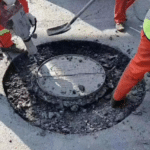Super heavy manhole covers are specialized infrastructure components engineered to withstand extreme weight and pressure. These covers are crucial in environments where heavy traffic, industrial activity, and specialized safety considerations demand extraordinary durability and performance. This article explores their application scope, features, and considerations for deployment.
Key Features of Super Heavy Manhole Covers
- Exceptional Load-Bearing Capacity Designed to support loads exceeding 350 kN, these covers are suitable for industrial and high-traffic zones like ports, airports, and highways. They can endure repeated stress from heavy vehicles without deformation or damage.
- Material Strength Typically made from ductile iron, cast iron, or advanced composite materials, these covers offer excellent resistance to corrosion, wear, and environmental factors.
- Safety and Ergonomics Features like anti-slip surfaces, secure locking mechanisms, and lightweight options for easier handling ensure both operational safety and theft prevention.
- Customizable Design Covers can be tailored to include aesthetic finishes or unique branding for specific industrial or municipal needs.
Application Scope
- Highways and Expressways Super heavy covers are essential on busy roads and highways to protect underground utilities from the impact of fast-moving, heavy vehicles. Their durability minimizes the risk of structural failures and road accidents.
- Industrial Zones In factories, warehouses, and loading docks, these covers protect critical access points in areas exposed to forklifts, trucks, and heavy machinery. They prevent damage to underground systems, ensuring uninterrupted operations.
- Ports and Airports Ports and airports require covers that can endure the weight of cranes, cargo vehicles, and airplanes. These covers often incorporate advanced sealing mechanisms to protect utilities from saline or corrosive environments.
- Urban Infrastructure High-capacity manhole covers are deployed in urban centers to manage underground utilities beneath bus terminals, metro stations, and crowded public spaces. Their anti-slip features reduce pedestrian risks, and locking systems prevent unauthorized access.
- Critical Facilities Facilities like power plants, oil refineries, and chemical factories demand covers resistant to extreme conditions, including exposure to chemicals, high temperatures, or hazardous gases. Composite covers are particularly advantageous here due to their non-corrosive and non-conductive properties.
Emerging Trends in Super Heavy Manhole Covers
- Sustainability Manufacturers are increasingly using recycled or eco-friendly materials to reduce environmental impact while maintaining high performance.
- Smart Monitoring Integrated sensors in covers provide real-time data on pressure, temperature, and potential leaks, enabling predictive maintenance and enhancing operational efficiency.
- Advanced Materials Composite materials are gaining popularity due to their lightweight properties combined with exceptional strength and corrosion resistance. These covers also reduce installation time and costs.
Considerations for Selection
- Load Requirements Always choose covers with load ratings suited to the specific application. For instance, extra heavy-duty covers are ideal for areas exposed to intense vehicular stress.
- Environmental Factors Coastal or humid environments benefit from corrosion-resistant materials like composites or treated iron.
- Safety and Accessibility Ensure covers have anti-slip surfaces and ergonomic lifting designs to minimize workplace injuries and improve operational efficiency.
Conclusion
Super heavy manhole covers are indispensable in infrastructure demanding exceptional durability and safety. Their diverse applications, from industrial zones to urban centers, underscore their importance in modern engineering. With innovations like smart monitoring and sustainable materials, these covers are evolving to meet the challenges of contemporary infrastructure development.





